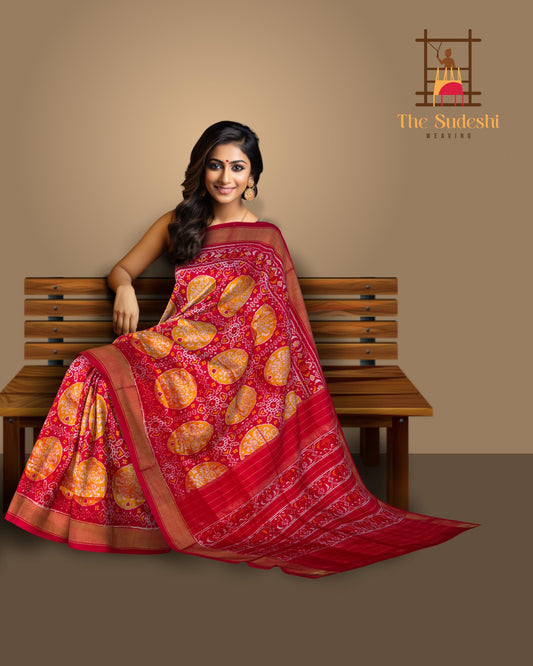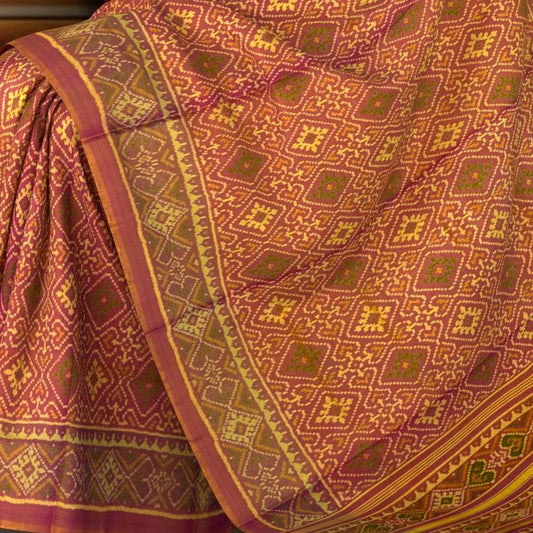Inspiring Journeys of Patola Weavers and Designers: Personal Stories, Challenges, and Successes
The timeless elegance of Patola sarees is not just a testament to intricate craftsmanship but also a reflection of the rich cultural heritage of India. These vibrant and intricate silk sarees have been revered for centuries, and the art of weaving them has been passed down through generations. In this blog post, we delve into the personal experiences and journeys of Patola weavers, explore the challenges they face, and celebrate their success stories and recognition in the modern world.
The Legacy of Patola Weaving
Patola sarees originate from Patan, Gujarat, and are renowned for their intricate designs and vibrant colors. The weaving process is labor-intensive and requires immense skill, often taking several months to complete a single saree. This traditional art form has been preserved by dedicated weavers who have devoted their lives to mastering the craft.
Personal Experiences and Journeys of Patola Weavers
To understand the true essence of Patola weaving, we spoke to several artisans who shared their personal stories and experiences.
Rajeshbhai Patel: A Fourth-Generation Weaver
Rajeshbhai Patel, a fourth-generation Patola weaver, has been weaving since he was a child. “I grew up watching my father and grandfather weave these beautiful sarees,” he reminisces. “The art of Patola weaving is in my blood. It’s not just a profession; it’s a way of life.”
Rajeshbhai’s journey has been one of dedication and passion. “We start by dyeing the threads using natural dyes, and then each thread is carefully woven into the fabric. It’s a meticulous process that requires precision and patience,” he explains. Despite the challenges, Rajeshbhai finds immense joy in his work. “Seeing the finished saree, knowing the effort and love that went into it, is incredibly fulfilling.”
Meena Devi: Breaking Barriers
Meena Devi is one of the few female Patola weavers in a traditionally male-dominated field. “I always had a keen interest in weaving, but it wasn’t easy to convince my family,” she shares. “However, my determination paid off, and today I am proud to be a Patola weaver.”
Meena’s journey has not been without obstacles. “There were times when I faced skepticism and doubt, but I was determined to prove myself,” she says. Her perseverance has earned her recognition and respect in the community. “Patola weaving is an art that requires not just skill but also creativity. Every saree I weave tells a story,” Meena adds with pride.
Challenges Faced by the Weaving Community
Despite the rich heritage and beauty of Patola sarees, the weaving community faces numerous challenges that threaten the survival of this ancient art form.
High Production Costs and Low Returns
One of the primary challenges is the high cost of production. The process of creating a Patola saree is time-consuming and labor-intensive, making it expensive. However, the returns are often not commensurate with the effort. “The market is flooded with machine-made imitations, which are cheaper and more accessible,” explains Rajeshbhai. “It’s difficult for traditional weavers to compete with these low-cost alternatives.”
Lack of Recognition and Support
Many weavers feel that their work does not receive the recognition it deserves. “There is a lack of awareness about the effort and skill that goes into making a Patola saree,” says Meena. “We need more support from the government and organizations to promote and preserve this art form.”
Declining Interest Among the Younger Generation
The younger generation is increasingly moving away from traditional crafts in search of more lucrative opportunities. “It’s disheartening to see that the younger generation is not interested in continuing the legacy,” says Rajeshbhai. “We need to find ways to make this craft more appealing and viable for them.”
Success Stories and Recognition
Despite the challenges, there are inspiring success stories of weavers who have gained recognition and acclaim for their work.
National Awards and International Recognition
Many Patola weavers have received national awards for their exceptional craftsmanship. Rajeshbhai was honored with a National Award for his contribution to Patola weaving. “Receiving the award was a proud moment for me and my family,” he says. “It’s a recognition of our hard work and dedication.”
International recognition has also helped in bringing attention to Patola sarees. “Exhibiting our work in international forums has opened up new opportunities,” says Meena. “It has helped in showcasing the beauty and intricacy of Patola sarees to a global audience.”
Revival Efforts by Designers
Several contemporary designers are working towards reviving Patola weaving by incorporating modern designs and techniques. “Collaborating with designers has been a great experience,” says Rajeshbhai. “It’s a way to keep the tradition alive while adapting to modern tastes.”
One such designer, Anjali Mehta, has been instrumental in promoting Patola sarees. “I have always been fascinated by the beauty of Patola sarees,” she says. “My aim is to blend traditional techniques with contemporary designs to create something unique and appealing.”
Conclusion
The art of Patola weaving is a testament to the skill, dedication, and creativity of the weavers. Their personal stories and journeys highlight the passion and perseverance required to keep this ancient craft alive. While the weaving community faces significant challenges, there are also inspiring success stories and efforts towards revival and recognition.
By supporting and promoting Patola sarees, we can ensure that this beautiful art form continues to thrive for generations to come. The stories of these weavers serve as an inspiration, reminding us of the rich cultural heritage and the timeless elegance of Patola sarees.







Leave a comment
Please note, comments need to be approved before they are published.